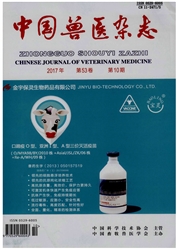

 中文摘要:
中文摘要:
本试验以SD大鼠为试验动物,利用摇床模拟公路运输过程中的摇晃、高温、噪音、饥渴、拥挤、碰撞6个主要的刺激因子,构建了大鼠运输应激模型。应激条件为60r/rain,35℃,每天应激2h。体重为270士20g,20只SD大鼠被随机均分为4组:对照组、应激1d组、应激2d组、应激3d组。在应激结束后,应激组大鼠体温均显著升高(P〈0.05),体重显著下降(P〈0.05),血清中皮质醇含量显著升高(P〈0.05)。试验结果与实际公路运输结果一致,表明运输应激模型构建成立。形态学研究显示,运输应激造成了大鼠空肠组织损伤,与对照组相比从应激第1天到应激第3天空肠绒毛脱落逐渐加剧。荧光定量PCR研究结果则显示,Hsp27,Hsp70和Hsp90mRNA的表达量也剧烈的升高。本试验研究表明,随着应激时间增加,大鼠空肠损伤逐渐加重,且HspsmRNA表达量升高,表明Hsps的表达量与运输应激造成空肠的损伤严重程度有关。运输应激后表达量急剧升高的保护性分子Hsps,是动物抵抗运输应激的重要机制之一。
 英文摘要:
英文摘要:
The objective of this study was to examine the effects of transportation stress on Ratsr Jejunum Morphology and HSPs mRNA expression using Sprague Dawley rats. The animals were subjected to shaking, heat, noise, hunger, crowded, collisions that were commonly-seen stress factors during transportation. The shaking conditions for the animal were 60 r/min on a shaker at 35℃and shaking time lasted two hours per day. Animals were divided into 4 groups, control, stressed-1 daystressed-2 daystressed-3 day-groups. We found that the body temperature increased(P〈0.05), the body weight decreased (P〈0.05), the serum cortisol increased(P〈0.05)in stressed rats as compared to that of controls. The morphological examination shows that the transportation stress had caused serious damages to the Jejunum of rats, also the intestinal villi desquamate form the top were pricked up from 1 day to 3 days. Results from Real-time PCR assay indicate that HSP27, HSP70 and HSP90 mRNAs expressions increased. This study shows that transportation stress could cause damage to rats jejunum and alter the HSPs mRNA expression.
 同期刊论文项目
同期刊论文项目
 同项目期刊论文
同项目期刊论文
 期刊信息
期刊信息
